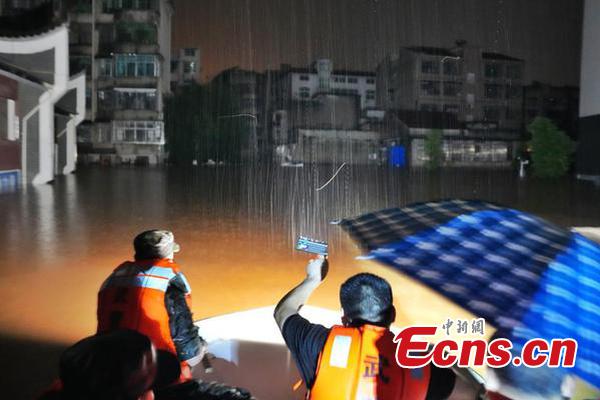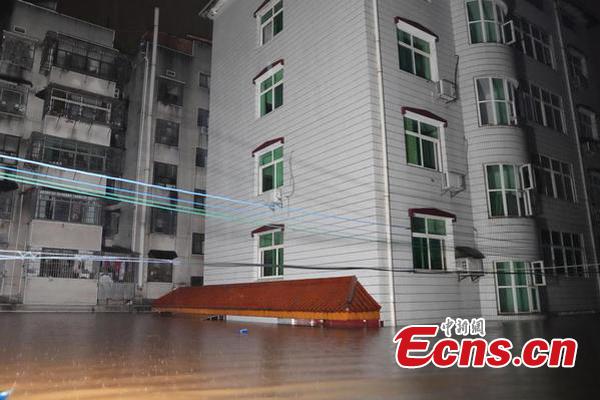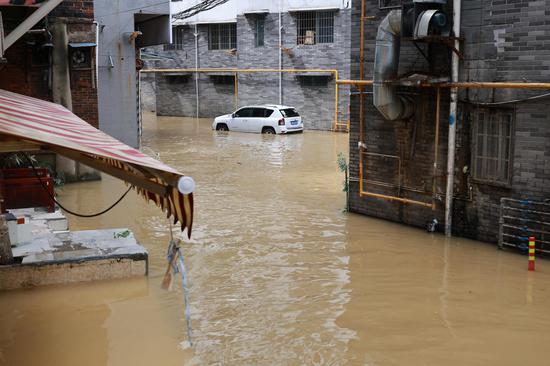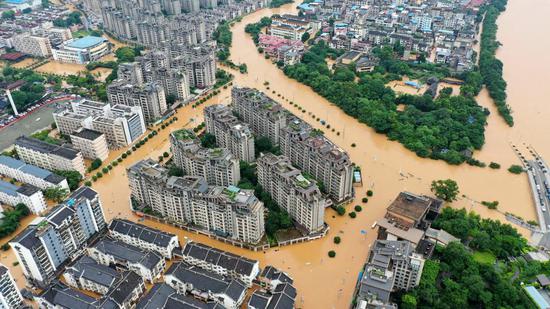(ECNS) -- South China is experiencing intense floods since the onset of the East Asian rainy season this year, with more 80 national meteorological stations—such as those of Changsha in Hunan Province; Hangzhou in Zhejiang Province and Anshun in Guizhou Province—reporting unprecedented cumulative precipitation, according to the Ministry of Water Resources.

Floods arrived two months early in the Pearl River Basin, with the Beijiang, Hanjiang, and Dongjiang rivers having experienced six floods since April. Notably, floods No.1 and No.2 along Beijiang River were the earliest and most severe on record since 1998.
Besides, floods have been more frequent and severe this year. More than 470 small and medium rivers in 21 provinces have exceeded warning levels, doubling the usual number. The water level at the Hankou hydrological station in Wuhan, Hubei Province reached 27.31 meters at 11:40 P.M. on Monday. At this point, the entire mainstream of the middle and lower reaches of the Yangtze River below the entrance of Dongting Lake in Hunan Province exceeded the warning level.
Zhou Lixian, a meteorological analyst at the China Meteorological Administration, said: "There has been an unusual abundance of rainfall in the southern regions in June, especially since June 17, with persistent heavy rain in the middle and lower reaches of the Yangtze River, as well as in Guangxi Zhuang Autonomous Region and Guizhou Province. Some stations, such as Huangshan in Anhui, Hangzhou in Zhejiang, Guilin and Liuzhou in Guangxi have recorded over 900 millimeters of rainfall, which could be disastrous."
The excessive rainfall is primarily due to the regions' location on the edge of the subtropical high-pressure belt. Strong and humid air currents, following the edge of the high-pressure system, transport moisture from the tropical oceans to these areas. Coupled with the southward diffusion of cold air from the north, prolonged confrontation between the cold and warm air masses has formed the Meiyu front, leading to the increased rainfall, Zhou said.
The Yangtze River Water Resources Commission maintains a Level III emergency response for flood defense, coordinating with local counterparts to manage 53 major reservoirs in the upper and middle reaches of the Yangtze River. The Three Gorges Reservoir has reduced its inflow from over 25,000 cubic meters per second to about 14,000 cubic meters per second, stored 39 billion cubic meters of floodwater and lowered downstream water levels by 0.15 to 0.7 meters, easing the pressure of flood prevention and control on the middle and lower Yangtze River.
Hunan Province, with the most reservoirs, is on high alert. In Changde City, which has over 1,300 reservoirs, with 260 at risk, authorities have increased patrols and integrated various data sources to enhance flood prediction and management.
As of Monday, Pingjiang County and Miluo City in Hunan Province have raised their emergency response levels to the highest. Pingjiang alone has deployed 166 rescue teams, with over 15,000 personnel and 1,695 sets of equipment to manage dike breaches and evacuate affected residents.

Heavy rains are expected to continue, with significant rainfall in the Yangtze, Taihu, and Xijiang River basins. However, from Wednesday, the rain might weaken in these areas and shift northwards.
After Friday, water levels of the main and tributary streams of the middle and lower reaches of the Yangtze River, as well as the Dongting Lake and Poyang Lake will gradually recede. Around July 15, the water levels are anticipated to fall below the warning levels across the board.


















































 京公网安备 11010202009201号
京公网安备 11010202009201号